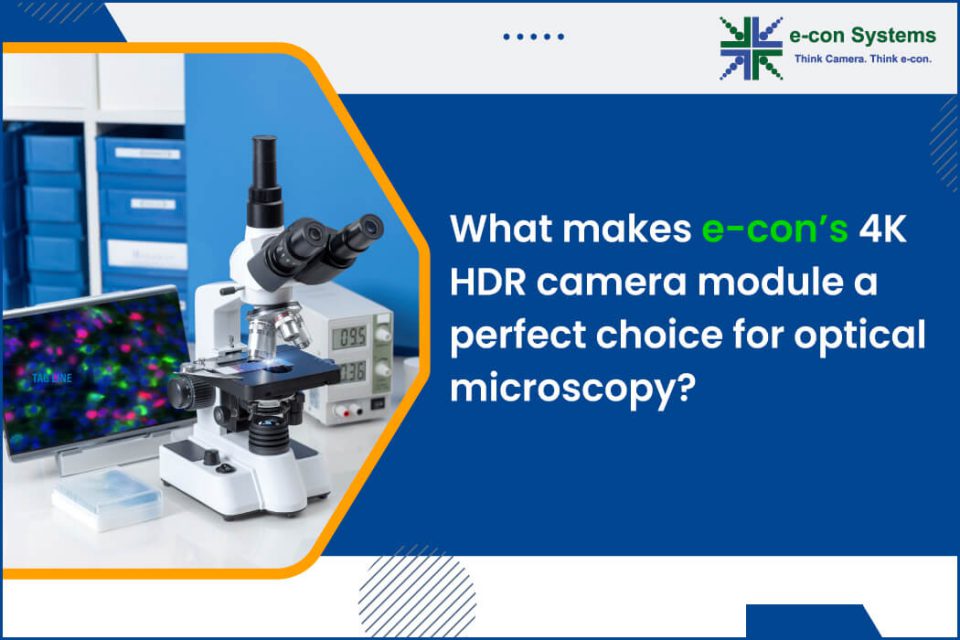Every microscopic application is unique, and so are its imaging requirements. e-con Systems has a series of cameras that can go well with different microscopic applications. But e-CAM82_CUMI0821_MOD, a 4K HDR MIPI camera module, is the perfect choice for optical microscopy. So, what makes it different from other cameras? In this blog post, let’s explore the benefits of this camera module and how it differentiates from other microscopic cameras.
What is a medical microscope – what is the role played by cameras in it?
In the field of life sciences, optical microscopes lay the foundation of how humans are treated for diseases. From dentistry and neurosurgery to ophthalmology, these microscopes are used to evaluate biological samples that the naked human eye is unequipped to detect. They can also enable accurate clinical screening/diagnosis by capturing cellular, molecular, and genetic images.
According to a top research firm in their market study, the worldwide surgical microscope market is expected to generate USD 3.5 billion (approx.) by 2031. Some of the reasons for their unexpected need in recent years include the increase in the elderly population, a growing number of chronic diseases, and a higher demand for minimally-invasive surgeries.
As you may have easily guessed, the performance of optical microscopes is directly impacted by the quality of the camera they leverage to extract accurate imaging data. Considering the in-depth analysis involved, it is extremely important to select the right camera.
Why e-CAM82_CUMI0821_MOD is the perfect choice for optical microscopes
Two of the most critical camera requirements of optical microscopy are producing high-quality images and bringing out even the minutest details of the sample specimen. e-CAM82_CUMI0821_MOD, an HDR, 8MP (4K) custom lens camera module, is equipped to make your application do both with ease. Based on the 1/2″ AR0821 CMOS image sensor from onsemi®, this camera solution also comes with a compact form factor and the ability to produce superior-quality images even in difficult lighting conditions.
Importance of AR0821 – 1/2″ sensor with a pixel size of 2.1µm
e-CAM82_CUMI0821_MOD is a custom lens 4K camera module based on the 1/2″ AR0821 HDR image sensor from onsemi®, which meets the key requirements of medical microscopes. With a pixel size of 2.1µm, this sensor can produce an enhanced image of the specimen with the ability to clearly view its tiny details – otherwise difficult to see by using a traditional microscope. Let’s see the benefits of this sensor in detail.
- High resolution: A higher resolution is critical in microscopic applications since it must capture smaller objects in detail. e-CAM82_CUMI0821_MOD has a high resolution of 4K and a pixel size of 2.1µm, which is capable of capturing the tiniest structures within the specimen that are difficult to view with typical optical microscopes (equipped with a lenses-based system that magnifies the image of the sample).

Fig 1: Image taken at e-CAM82_CUMI0821_MOD – High resolution
- High Dynamic Range: When it comes to accurate diagnosis in optical microscopy, the camera’s ability to recognize the several color shades present on the sample slide is critical. Test samples with extremely bright and extremely dark regions will lose detail and might result in missing crucial information. For instance, given below is an image taken using an ordinary (non HDR camera):

Fig 2: Left Side(e-CAM82_CUMI0821_MOD – HDR), Right Side (Non HDR Camera)
e-CAM82_CUMI0821_MOD is an HDR camera module that uses multiple exposures in a single frame to bring out details in the brightest as well as darkest areas of the same scene in high-contrast lighting conditions, which in turn results in accurate color reproduction.
- High sensitivity and SNR (Signal to Noise Ratio): On the one side, high sensitivity allows efficient conversion of low light mages to quality outputs. On the other, high SNR provides more useful information (signal) than unwanted data (noise), making these features a boon for microscopic applications. e-CAM82_CUMI0821_MOD, with its high sensitivity and SNR, captures images with fine details even in extremely low lighting conditions.

Fig 3: Right Side(e-CAM82_CUMI0821_MOD), Left Side (Other Camera)
e-con Systems’ expertise in developing world-class microscopic cameras
As you can see, e-CAM82_CUMI0821_MOD can be your microscopic application’s camera module of choice to ensure top performance. Furthermore, it can also be connected to any host platform using the USB, MIPI, and GMSL2 interfaces, making it even more flexible when it comes to platform compatibility.
e-con Systems, with 18+ years of experience and expertise in embedded vision, has developed a vast portfolio of cameras exclusively for microscopic applications. It also has a proven track record of successfully delivering camera solutions for many medical customers. Our ISP fine-tuning expertise also distinguishes us as a standout embedded vision partner of choice. We have the ability to fully customize your camera parameters in order to deliver the best possible image quality for your application.
Related Cameras:
- See3CAM_CU135 – 4K USB Camera
- See3CAM_CU135M – 4K Monochrome USB 3.1 Gen 1 Camera
- See3CAM_CU81 – AR0821 4K HDR USB Camera with 1/2″ Sensor
- See3CAM_CU55 – 1/2.5″ 5.0 MP Low Noise USB Camera (Color)
- See3CAM_CU55M – 5MP Monochrome USB NIR Camera
- e-CAM84_CUMI485C_MOD – Sony® Starvis™ IMX485 Ultra-Lowlight Camera Module
To discover more about e-con’s camera solutions for ophthalmology, please check out our Markets page. You can also visit the Camera Selector to browse through our entire portfolio. Of course, if you are looking for any help in integrating cameras into your microscope-based applications, please write to us at camerasolutions@e-consystems.com.

Balaji is a camera expert with 18+ years of experience in embedded product design, camera solutions, and product development. In e-con Systems, he has built numerous camera solutions in the field of ophthalmology, laboratory equipment, dentistry, assistive technology, dermatology, and more. He has played an integral part in helping many customers build their products by integrating the right vision technology into them.




